-
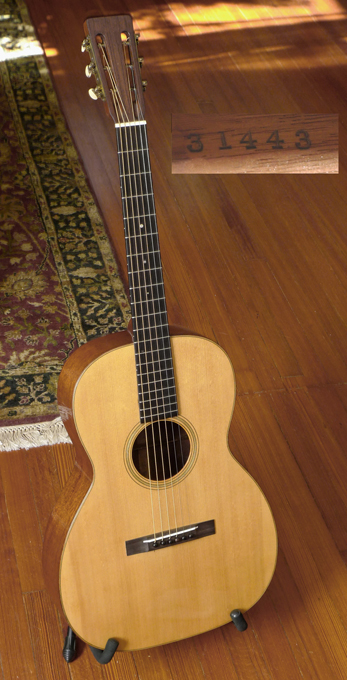 Long-scale, 000 sized 12-fret Martins from the late 20’s are among the most sought-after prewar instruments. This was the biggest, loudest Martin made for steel strings in this era, with a 25.4 inch scale length, the same scale length as a 30’s D-45. (The 14-fret 000’s of the 30s and later have a shorter, 24.5 inch scale). In no other instrument will you get the resonance (from thin tops and back), combined with the long scale length. It’s a big pre-war Martin 12-fret. That’s why this instrument is one of the most highly sought-after prewar Martins– and increasingly very difficult to find. But it’s all about one thing: the tone, emanating from a large-bodied 12-fret that plays wonderfully, and loud, even with the most delicate fingerpicking. The bass response here is the best you will ever find in any prewar Martin 12-fret guitar. This wonderful 000-18 was set up restored and set up by none other than Gruhn Guitars in Nashville– to impeccable standards. Gruhn refinished the top, back and sides. Neck, fretboard, headstock, are all original finish. Gruhn also replaced the bridge with a perfectly correct ebony bridge. The guitar has its original bridgeplate. New, period-correct Bar frets were installed by Gruhn. 1 7/8” nut. Mahogany back and sides. Adirondack spruce top. Ebony fingerboard. It has original tuners (gear wheel below worm gear, ivoroid buttons). The top and back of the guitar are completely crack-free and perfect– with full thickness the same as the day they left the factory. And the totally crack-free top shows absolutely perfect form and shape, with no undue bellying behind the bridge. There are a couple of almost imperceptible side cracks that were addressed by Gruhn, almost impossible to see from the outside. One of the most sought-after prewar Martin 12-frets, restored correctly, and set up, by the world’s best. (Included: a signed, in-hand Appraisal of the guitar– by George Gruhn)
Long-scale, 000 sized 12-fret Martins from the late 20’s are among the most sought-after prewar instruments. This was the biggest, loudest Martin made for steel strings in this era, with a 25.4 inch scale length, the same scale length as a 30’s D-45. (The 14-fret 000’s of the 30s and later have a shorter, 24.5 inch scale). In no other instrument will you get the resonance (from thin tops and back), combined with the long scale length. It’s a big pre-war Martin 12-fret. That’s why this instrument is one of the most highly sought-after prewar Martins– and increasingly very difficult to find. But it’s all about one thing: the tone, emanating from a large-bodied 12-fret that plays wonderfully, and loud, even with the most delicate fingerpicking. The bass response here is the best you will ever find in any prewar Martin 12-fret guitar. This wonderful 000-18 was set up restored and set up by none other than Gruhn Guitars in Nashville– to impeccable standards. Gruhn refinished the top, back and sides. Neck, fretboard, headstock, are all original finish. Gruhn also replaced the bridge with a perfectly correct ebony bridge. The guitar has its original bridgeplate. New, period-correct Bar frets were installed by Gruhn. 1 7/8” nut. Mahogany back and sides. Adirondack spruce top. Ebony fingerboard. It has original tuners (gear wheel below worm gear, ivoroid buttons). The top and back of the guitar are completely crack-free and perfect– with full thickness the same as the day they left the factory. And the totally crack-free top shows absolutely perfect form and shape, with no undue bellying behind the bridge. There are a couple of almost imperceptible side cracks that were addressed by Gruhn, almost impossible to see from the outside. One of the most sought-after prewar Martin 12-frets, restored correctly, and set up, by the world’s best. (Included: a signed, in-hand Appraisal of the guitar– by George Gruhn) -
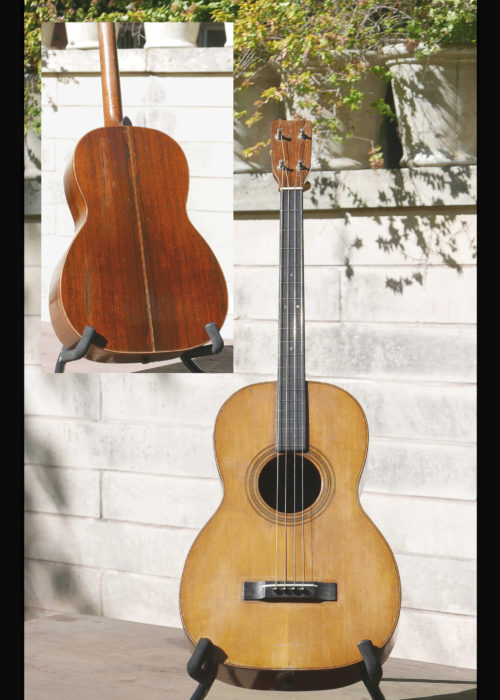 The 5-21 Martins, with their Brazilian Rosewood back and sides and Adirondack spruce tops, are known for putting out an astounding amount of sound. This tenor guitar, style 5-21T, does that in spades. Measuring 11-3/8" across, with its X braced top and light build, the instrument has an amazing amount of tone. Though Martin offered size 5 models ranging from style 15 through the elaborately ornamented style 45, the only ones made in any significant quantity prior to World War II were the style 17, 18, and 21 in six-string guitars and styles 17, 18, and 21 tenors, as well as some style 15 post-war size 5 tenors. Features of this instrument:
The 5-21 Martins, with their Brazilian Rosewood back and sides and Adirondack spruce tops, are known for putting out an astounding amount of sound. This tenor guitar, style 5-21T, does that in spades. Measuring 11-3/8" across, with its X braced top and light build, the instrument has an amazing amount of tone. Though Martin offered size 5 models ranging from style 15 through the elaborately ornamented style 45, the only ones made in any significant quantity prior to World War II were the style 17, 18, and 21 in six-string guitars and styles 17, 18, and 21 tenors, as well as some style 15 post-war size 5 tenors. Features of this instrument:- Recent neck set, and leveling of original bar frets, action is very good
- Original Grover tuning machines, working well
- Nut width of 1 1/4"
- Scale length: 22.5"
- 1 3/8" string spacing at the saddle
- Had an added tailpiece at once point (3 tiny screw holes near end pin
- No top cracks
- One repaired 11" crack on the bottom lower bout side
- One 6" repaired crack on the upper bout back under the herring bone center inlay,
- One 4” repaired crack on the lower bout back towards the bottom
- A small hole at the center of the rear headstock– probably at some point for a nail to hang the instrument on a wall
- Neck has a comfortable V shape, leaning toward a U profile
-
 The instrument features the original ebony bridge (full height), original tuners, original ivory saddle and nut, original maple bridge plate. Ebony fretboard. Bar frets. Thin, Soft-V neck. Finish is original. There is some overspray on the top, which is confined mainly to below the soundhole (over about the same size area, as what a pickguard would cover–but it never had a pickguard), and a bit below the bridge, and very very light on other areas of the top. Apparently a previous owner wanted to address the pick/finger wear and a repaired crack below the bridge. It's generally unobtrusive, no effect on the color of the top, and not noticeable from a few feet. Also, some light overspray on back and sides. As overspray goes, it has minimal effect on the appearance. Neck, and head have no overspray at all. There is one crack on the instrument from the bridge to the bottom of the guitar, but it's well repaired (it's about a half-inch from the center seam, below the bridge). Also about a 2 1/2 inch shallow crack/finish crack near where the fretboard meets the top (about 1/8 inch from the fretboard), on low-E side (does not go through–It is not visible on underside of top). There is a small indentation on the side rosewood (about one inch in area, on the side/lower, stable.) 1-7/8 inch nut. Action is 3/32 inch high E string/12th fret. 4/32 low E string… just right to get that full, cascading Brazilian tone from this fine 0-21.
The instrument features the original ebony bridge (full height), original tuners, original ivory saddle and nut, original maple bridge plate. Ebony fretboard. Bar frets. Thin, Soft-V neck. Finish is original. There is some overspray on the top, which is confined mainly to below the soundhole (over about the same size area, as what a pickguard would cover–but it never had a pickguard), and a bit below the bridge, and very very light on other areas of the top. Apparently a previous owner wanted to address the pick/finger wear and a repaired crack below the bridge. It's generally unobtrusive, no effect on the color of the top, and not noticeable from a few feet. Also, some light overspray on back and sides. As overspray goes, it has minimal effect on the appearance. Neck, and head have no overspray at all. There is one crack on the instrument from the bridge to the bottom of the guitar, but it's well repaired (it's about a half-inch from the center seam, below the bridge). Also about a 2 1/2 inch shallow crack/finish crack near where the fretboard meets the top (about 1/8 inch from the fretboard), on low-E side (does not go through–It is not visible on underside of top). There is a small indentation on the side rosewood (about one inch in area, on the side/lower, stable.) 1-7/8 inch nut. Action is 3/32 inch high E string/12th fret. 4/32 low E string… just right to get that full, cascading Brazilian tone from this fine 0-21. -
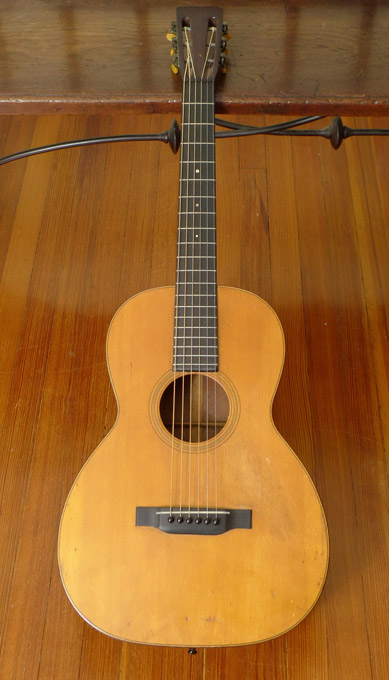 A great sounding 00-18, from the era when 18’s were light as a feather and have the resonance that result in singular tone– and this one from the time when Martin had just moved away from the pyramid bridge and to the belly bridge.
A great sounding 00-18, from the era when 18’s were light as a feather and have the resonance that result in singular tone– and this one from the time when Martin had just moved away from the pyramid bridge and to the belly bridge.- Original finish (with a bit of overspray, only on the area below the soundhole (typical light overspray where there was pick wear)
- Has just had neck set, here, perfect job
- Has just been refret, with period correct Bar frets obtained from TJ Thompson
- New, exact duplicate bridge made (it had its original belly bridge, but it had a crack and we preferred to replace the bridge with a perfect reproduction ebony belly bridge. New bridge, is on exact, correct footprint of original bridge
- the top of the guitar is crack-free
- the back of the guitar is crack-free
- Repaired side cracks, on both treble and bass sides
-
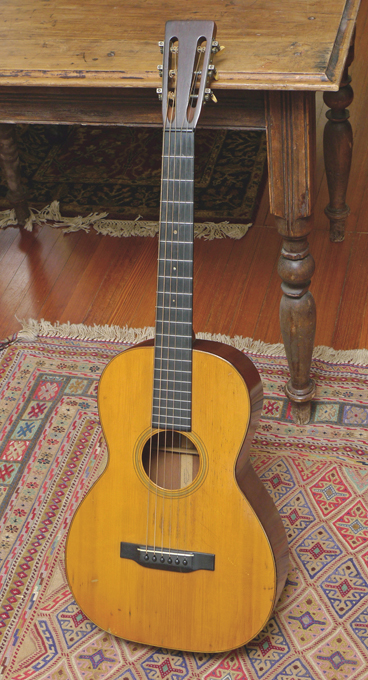 An all-original Martin from the finest era in the company’s history, this 0-18 is unsurpassed for Martin 12-fret Adirondack spruce over Mahogany tone. What can you add about a 1930 Martin, that is 100% original, down to the original bridge pins, and original ivory saddle This example is from the time when Martin had just started using belly bridges, and the ebony belly bridge on this guitar still has its original ivory saddle. And this guitar is 100% crack-free. Period. The instrument features the original bridge (full height), original tuners, original ivory saddle, original nut, and original maple bridge plate (the bridge plate shows almost no wear from ball ends–almost unheard of in a prewar Martin). All original finish– everywhere. Some honest playwear and various minor nicks and dings give the wonderfully aged and naturally honey-hued Adirondack top character. The top shows perfect form, with no bellying behind the bridge, etc. One of the things that makes Martin’s from these year so great-sounding: Martin was still using a thin ebony rod inside the neck, not a metal bar. So the instrument is more free to resonate, from tuners, right down to the bridge. And resonate this one does, with a strong bass especially that puts many many large size guitars to shame. 1-7/8 inch nut. The neck has just been set, by us, retaining the original Bar frets
An all-original Martin from the finest era in the company’s history, this 0-18 is unsurpassed for Martin 12-fret Adirondack spruce over Mahogany tone. What can you add about a 1930 Martin, that is 100% original, down to the original bridge pins, and original ivory saddle This example is from the time when Martin had just started using belly bridges, and the ebony belly bridge on this guitar still has its original ivory saddle. And this guitar is 100% crack-free. Period. The instrument features the original bridge (full height), original tuners, original ivory saddle, original nut, and original maple bridge plate (the bridge plate shows almost no wear from ball ends–almost unheard of in a prewar Martin). All original finish– everywhere. Some honest playwear and various minor nicks and dings give the wonderfully aged and naturally honey-hued Adirondack top character. The top shows perfect form, with no bellying behind the bridge, etc. One of the things that makes Martin’s from these year so great-sounding: Martin was still using a thin ebony rod inside the neck, not a metal bar. So the instrument is more free to resonate, from tuners, right down to the bridge. And resonate this one does, with a strong bass especially that puts many many large size guitars to shame. 1-7/8 inch nut. The neck has just been set, by us, retaining the original Bar frets -
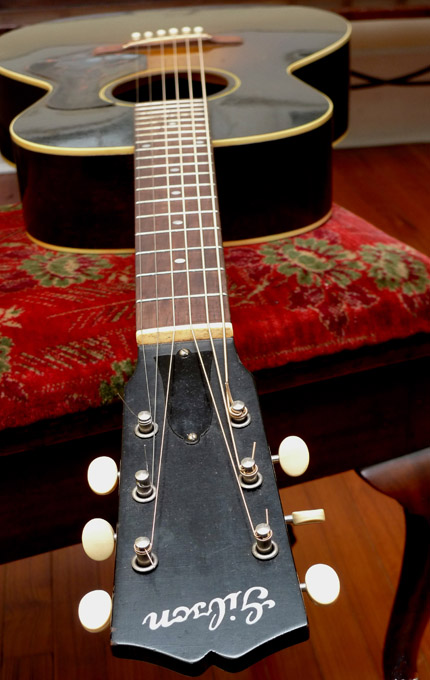 Crack-free, and 100% original, down to the bridge pins, and the original Geib case. Just getting a neck set to make it play perfectly.
Crack-free, and 100% original, down to the bridge pins, and the original Geib case. Just getting a neck set to make it play perfectly. -
 The Larson Brothers need little introduction to the world’s top players and collectors, and they are very different instruments from the Martin and Gibson instruments that dominated the 1920’s and 30’s by their shear numbers. Larson instruments are rising in value rapidly, as they never produced the kind of volume that Martin much less Gibson produced in those decades, and they are now recognized for their magnificent workmanship and tone. The now legendary Chicago-based Larson brothers, August and Carl, did not make instruments with a “Larson” label. All of their instruments were branded and marketed for Stahl, Maurer, Prairie State, Euphonon, Dyer, Bruno, and a few more. Yet every one of their instruments has their unmistakable trademarks. And their unmistakable tone. This exquisitely beautiful, 100% original Larson Mandolin was made at the very height of the Larson legacy– when they were making their finest instruments. It has all of the Larson trademarks that set apart the best Larsons, including “built under tension” design, and Larson’s classic “ebony under the binding” on the neck. Every part of this instrument is 100% original. And its crack-free– save for two tiny dryness finish cracks near center of back, of about two inches each.
The Larson Brothers need little introduction to the world’s top players and collectors, and they are very different instruments from the Martin and Gibson instruments that dominated the 1920’s and 30’s by their shear numbers. Larson instruments are rising in value rapidly, as they never produced the kind of volume that Martin much less Gibson produced in those decades, and they are now recognized for their magnificent workmanship and tone. The now legendary Chicago-based Larson brothers, August and Carl, did not make instruments with a “Larson” label. All of their instruments were branded and marketed for Stahl, Maurer, Prairie State, Euphonon, Dyer, Bruno, and a few more. Yet every one of their instruments has their unmistakable trademarks. And their unmistakable tone. This exquisitely beautiful, 100% original Larson Mandolin was made at the very height of the Larson legacy– when they were making their finest instruments. It has all of the Larson trademarks that set apart the best Larsons, including “built under tension” design, and Larson’s classic “ebony under the binding” on the neck. Every part of this instrument is 100% original. And its crack-free– save for two tiny dryness finish cracks near center of back, of about two inches each.- 100% original finish, everywhere
- Scale length: 13 inches
- Nut width: 1 1/8 inches
- Serial number: 38764
-
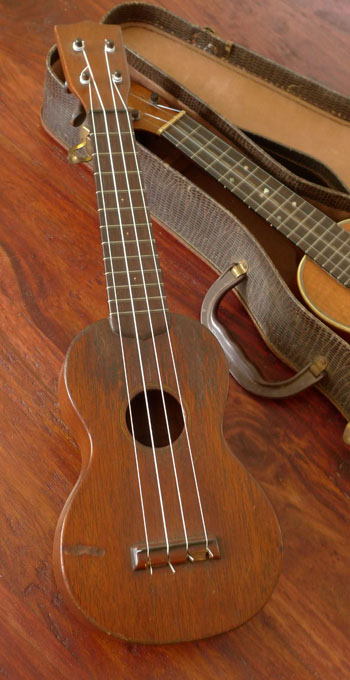 A pre-decal Uke from Martin. Style 0, with no body binding. Well worn, but 100% crack free.
A pre-decal Uke from Martin. Style 0, with no body binding. Well worn, but 100% crack free. -
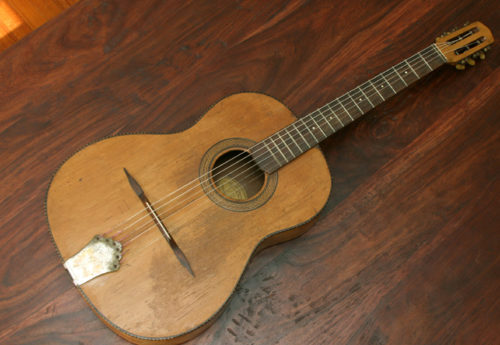 When Martin entered into its “Golden Age” for the flat top guitar, the jazz guitar was evolving on a parallel and equally important track. And in Europe, especially France, they had their own ideas about guitar making, and produced some brilliant guitars in this era–including of course the wonderful Selmer gypsy jazz guitar. The brothers Gerome were among the best luthiers in Mirecourt, France, a city famous in Europe for producing the finest gypsy and jazz guitars, in the 20s, 30s, and 40s. This all original, gypsy style guitar has maple back and sides, to give that high, twangy tone, just what you want in a django-style guitar. This one has loud piercing trebles–the treble strings are louder and more piercing than any guitar of any kind I have ever heard. Only maple produces that loud sharp treble. The volume of this instrument is striking, and there is almost a “reverb”, resonant quality to the tone. Solid spruce top. Black & white checkerboard marquetry binding on top, and rosette. It has a very thick rosewood fingerboard (over 4/10 inches/10.5mm thick!) Maple neck. Nut just shy of 1 7/8 inch. Wonderful bakelite buttons on the tuners. And it would not be a genuine gypsy jazz classic, if it did not have the hallmarks of this style: the original “floating bridge”–not an “adjustable brigde” for height, but a floating rosewood bridge that is not glued to the top, but held on by string tension (the “wings” of the bridge are glued to the top in this configuration). (You can of course change the intonation with this set-up.) The other feature that is a must, is the “zero fret”, i.e. there is a fret (the “zero” fret) right in front of the nut. 14-5/8 inch wide at lower bout. All original finish. A couple of small cracks on top. Top center seam repair. Original T-frets show wear, but still work fine. No buzzing. Action is good. Takes loop-end strings (available from many sources–Savarez Argentine strings are great on this instrument).
When Martin entered into its “Golden Age” for the flat top guitar, the jazz guitar was evolving on a parallel and equally important track. And in Europe, especially France, they had their own ideas about guitar making, and produced some brilliant guitars in this era–including of course the wonderful Selmer gypsy jazz guitar. The brothers Gerome were among the best luthiers in Mirecourt, France, a city famous in Europe for producing the finest gypsy and jazz guitars, in the 20s, 30s, and 40s. This all original, gypsy style guitar has maple back and sides, to give that high, twangy tone, just what you want in a django-style guitar. This one has loud piercing trebles–the treble strings are louder and more piercing than any guitar of any kind I have ever heard. Only maple produces that loud sharp treble. The volume of this instrument is striking, and there is almost a “reverb”, resonant quality to the tone. Solid spruce top. Black & white checkerboard marquetry binding on top, and rosette. It has a very thick rosewood fingerboard (over 4/10 inches/10.5mm thick!) Maple neck. Nut just shy of 1 7/8 inch. Wonderful bakelite buttons on the tuners. And it would not be a genuine gypsy jazz classic, if it did not have the hallmarks of this style: the original “floating bridge”–not an “adjustable brigde” for height, but a floating rosewood bridge that is not glued to the top, but held on by string tension (the “wings” of the bridge are glued to the top in this configuration). (You can of course change the intonation with this set-up.) The other feature that is a must, is the “zero fret”, i.e. there is a fret (the “zero” fret) right in front of the nut. 14-5/8 inch wide at lower bout. All original finish. A couple of small cracks on top. Top center seam repair. Original T-frets show wear, but still work fine. No buzzing. Action is good. Takes loop-end strings (available from many sources–Savarez Argentine strings are great on this instrument). -
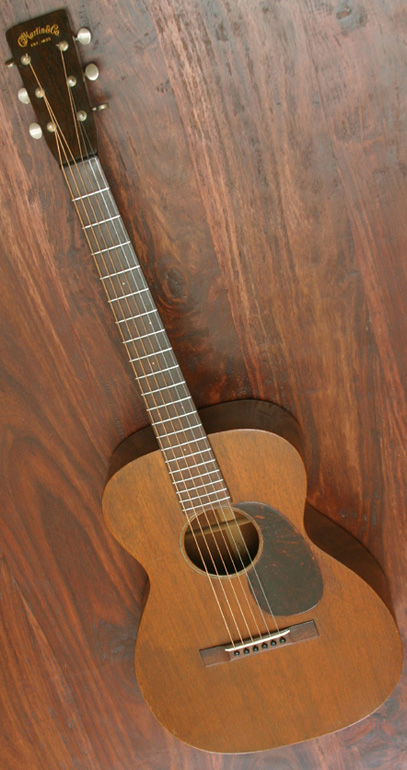 It’s rare to find a Golden Era Martin in this condition. This wonderful, completely crack-free 14-fret guitar from the 30’s is a gem. It’s one of the very first Martins of any style to have all three: 14 frets clear of body+Martin decal on the front of the peghead+Martin stamp the back of the peghead. Mahogany top, back and sides, of course, and it has the great, resonant feel and tone of a very lightly built 12-fret, but with more volume, in a 14-fret package. Strong bass response. 1 3/4 inch nut. Original finish, everywhere; no cracks anywhere. Original tuners. Original full-height bridge and maple bridge plate. Original bridge pins, and nut. The neck was recently set, so there is a new bone saddle, and the action is nice and low. Original bar frets. Some slight wear below the pick guard (not a hint of a crack or even any shrinking of the edges of the pick guard), and a variety of minor dings– but this completely crack-free guitar from the Martin Golden era is a gem.
It’s rare to find a Golden Era Martin in this condition. This wonderful, completely crack-free 14-fret guitar from the 30’s is a gem. It’s one of the very first Martins of any style to have all three: 14 frets clear of body+Martin decal on the front of the peghead+Martin stamp the back of the peghead. Mahogany top, back and sides, of course, and it has the great, resonant feel and tone of a very lightly built 12-fret, but with more volume, in a 14-fret package. Strong bass response. 1 3/4 inch nut. Original finish, everywhere; no cracks anywhere. Original tuners. Original full-height bridge and maple bridge plate. Original bridge pins, and nut. The neck was recently set, so there is a new bone saddle, and the action is nice and low. Original bar frets. Some slight wear below the pick guard (not a hint of a crack or even any shrinking of the edges of the pick guard), and a variety of minor dings– but this completely crack-free guitar from the Martin Golden era is a gem. -
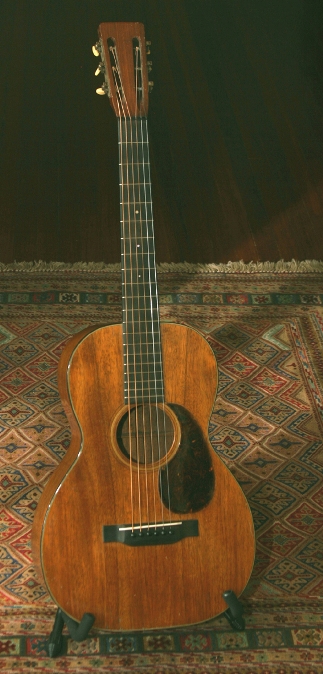 We converted this Golden Era 12-fret Koa Martin from the original Hawaiian setup ourselves, so it's perfect. The instrument does not have a crack anywhere. All original finish. Original Ebony bridge, converted from the tall Hawaiian set-up to a normal 30's set-up. Same with the ebony nut. All new, period-perfect Bar Frets. We radiused the ebony fretboard to 30's Martin specs. Neck was set and action is perfect. 1-7/8 inch nut width. Original tuners. Original bridge plate. Minor nicks and dings on top and back, but with the all original finish and crack-free, it's a rare specimen. Nothing compares in tone to an all-Koa Golden Age Martin. Koa blends the midrange of mahogany with the top end of maple-or, in the case of a fine 30's Koa Martin- hints of Brazilian rosewood. This fine 0-18K has all you would want from a Koa Martin, with the clearest, bell-like treble string tone imaginable.
We converted this Golden Era 12-fret Koa Martin from the original Hawaiian setup ourselves, so it's perfect. The instrument does not have a crack anywhere. All original finish. Original Ebony bridge, converted from the tall Hawaiian set-up to a normal 30's set-up. Same with the ebony nut. All new, period-perfect Bar Frets. We radiused the ebony fretboard to 30's Martin specs. Neck was set and action is perfect. 1-7/8 inch nut width. Original tuners. Original bridge plate. Minor nicks and dings on top and back, but with the all original finish and crack-free, it's a rare specimen. Nothing compares in tone to an all-Koa Golden Age Martin. Koa blends the midrange of mahogany with the top end of maple-or, in the case of a fine 30's Koa Martin- hints of Brazilian rosewood. This fine 0-18K has all you would want from a Koa Martin, with the clearest, bell-like treble string tone imaginable. -
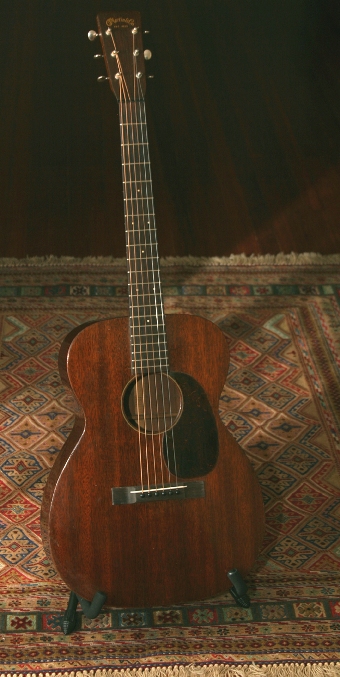 This model is something of a sleeper on the Golden Era Martin guitar market, because there are just not that many pre-1939 00-17s available. There are quite a few war-time and post-war 00-17s, but a 00-17 with full pre-war specs, forward shifted X-bracing, and 1 3/4 inch nut, is hard to come by–and they have all the great qualities of 00-sized Golden Era Martins that cost twice or three times the price on the vintage market–for now, as these great pre-war 00-17s will catch up quickly. The tone and volume of this 00-17 is astounding: full, amazingly bright, and with impressive volume. 1-3/4 inch nut width. Crack-free except for a well-repaired crack on bass side, about 2 inches long, that's difficult to see even up close. No cracks at all on top, or back. All original finish. Original bridge plate. This model has of course a mahogany top as well as mahogany back and sides. And with that dark look and original gloss finish that really sets this Golden Age Martin apart in its own class. Neck has the typically slightly beefier profile that's the hallmark of the best 30's 14-fret Martins. Neck was set by us. Replaced, period-correct Brazilian rosewood bridge. Original ebony nut. All new T-frets installed by us. Original tuners.
This model is something of a sleeper on the Golden Era Martin guitar market, because there are just not that many pre-1939 00-17s available. There are quite a few war-time and post-war 00-17s, but a 00-17 with full pre-war specs, forward shifted X-bracing, and 1 3/4 inch nut, is hard to come by–and they have all the great qualities of 00-sized Golden Era Martins that cost twice or three times the price on the vintage market–for now, as these great pre-war 00-17s will catch up quickly. The tone and volume of this 00-17 is astounding: full, amazingly bright, and with impressive volume. 1-3/4 inch nut width. Crack-free except for a well-repaired crack on bass side, about 2 inches long, that's difficult to see even up close. No cracks at all on top, or back. All original finish. Original bridge plate. This model has of course a mahogany top as well as mahogany back and sides. And with that dark look and original gloss finish that really sets this Golden Age Martin apart in its own class. Neck has the typically slightly beefier profile that's the hallmark of the best 30's 14-fret Martins. Neck was set by us. Replaced, period-correct Brazilian rosewood bridge. Original ebony nut. All new T-frets installed by us. Original tuners. -
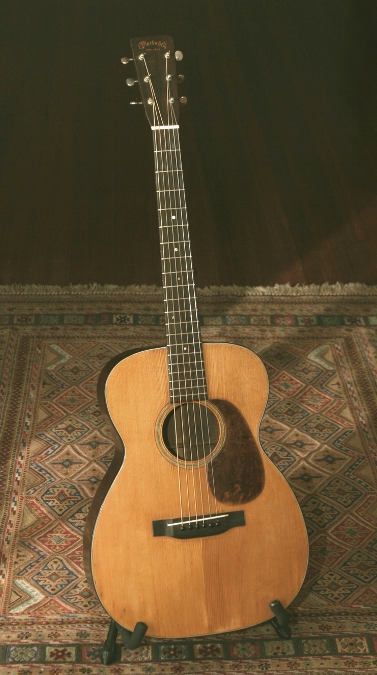 Probably the best year ever for 14-fret 00-18s. In the Golden Age of 14-fret Martins from the early 30's until the late 30's, only in 1936 did Martin use Brazilian rosewood (as opposed to ebony) for the fretboard and bridges of 18's, so its tone is considered by many to be the best in the 14 fret, 1-3/4 inch nut era. The guitar is crack-free on the top and back. Just one repaired crack on the treble side.The repair is well done and almost impossible to see from the outside (older repair has muslin cloth on inside-luthiers agree that these older cloth patches inside a vintage Martin should be left in place). Original tuners. Original bridge plate. Original nut. Replaced T-frets by us. Replacement bridge-very dark Brazilian rosewood bridge made to original specs in our shop, and ivory saddle. The neck has that wonderful mid-thirties slightly fatter profile. Neck set by us. And the tone is the best example of a Golden Era 00-18 you'll find anywhere. Light overspray (no refinishing) on back and sides (not top, neck or head).
Probably the best year ever for 14-fret 00-18s. In the Golden Age of 14-fret Martins from the early 30's until the late 30's, only in 1936 did Martin use Brazilian rosewood (as opposed to ebony) for the fretboard and bridges of 18's, so its tone is considered by many to be the best in the 14 fret, 1-3/4 inch nut era. The guitar is crack-free on the top and back. Just one repaired crack on the treble side.The repair is well done and almost impossible to see from the outside (older repair has muslin cloth on inside-luthiers agree that these older cloth patches inside a vintage Martin should be left in place). Original tuners. Original bridge plate. Original nut. Replaced T-frets by us. Replacement bridge-very dark Brazilian rosewood bridge made to original specs in our shop, and ivory saddle. The neck has that wonderful mid-thirties slightly fatter profile. Neck set by us. And the tone is the best example of a Golden Era 00-18 you'll find anywhere. Light overspray (no refinishing) on back and sides (not top, neck or head). -
 Another Gibson L-00, with great tone and volume, and all original finish. The top and sides are completely crack-free, and there are several small dryness cracks on the back. The bridge is original, and has never been off the guitar. We just set the neck, and installed a new bone saddle. The bridge plate is original and in perfect condition. Original firestripe pickguard. Original nut. Original frets.
Another Gibson L-00, with great tone and volume, and all original finish. The top and sides are completely crack-free, and there are several small dryness cracks on the back. The bridge is original, and has never been off the guitar. We just set the neck, and installed a new bone saddle. The bridge plate is original and in perfect condition. Original firestripe pickguard. Original nut. Original frets. -
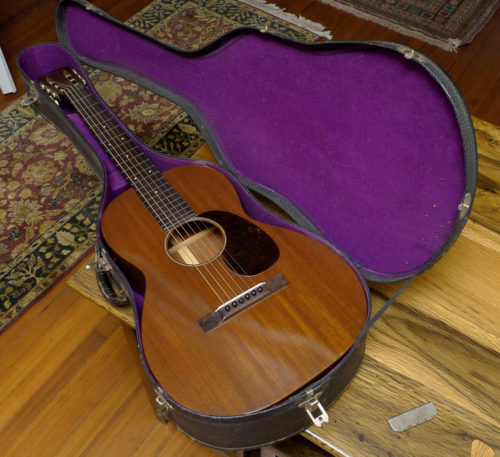 If there is a better-preserved Martin guitar from 1937, we have not seen it. This instrument is as an almost time-capsule condition 0-17H, still in its original case. And of course with its original Hawaiian set up. Many people convert these pre-war Martin Hawaiian set up guitars, to “Spanish” style, i.e. regular steel-string flat top set up. And that is certainly an option for whoever acquires this instrument. But this example, is just too nice, and too original for us to want to convert it. And the tone is exquisite (On request, we’ll send you a link to a video/audio clip of one of this country’s best, most famous dobro/pedal steel players playing slide on this great Martin 0-17H, right here in our shop.) All mahogany of course: mahogany back, sides, and top. Brazilian rosewood bridge, and fretboard. The guitar has no play wear. We won’t call it pristine– even under-the bed-guitars that have not really been played, have a few nicks from just being in the case and moved around a couple of times in 70+ years. But it’s as close to perfect as you’ll find in any 1930’s Martin. The neck is straight as an arrow, showing no bowing at all. No cracks of any kind. All original parts, period– down to the nut, bridge pins, and ivory saddle. The guitar is 12 fret to the body, unlike the regular 0-17’s from this period that were 14-fret.
If there is a better-preserved Martin guitar from 1937, we have not seen it. This instrument is as an almost time-capsule condition 0-17H, still in its original case. And of course with its original Hawaiian set up. Many people convert these pre-war Martin Hawaiian set up guitars, to “Spanish” style, i.e. regular steel-string flat top set up. And that is certainly an option for whoever acquires this instrument. But this example, is just too nice, and too original for us to want to convert it. And the tone is exquisite (On request, we’ll send you a link to a video/audio clip of one of this country’s best, most famous dobro/pedal steel players playing slide on this great Martin 0-17H, right here in our shop.) All mahogany of course: mahogany back, sides, and top. Brazilian rosewood bridge, and fretboard. The guitar has no play wear. We won’t call it pristine– even under-the bed-guitars that have not really been played, have a few nicks from just being in the case and moved around a couple of times in 70+ years. But it’s as close to perfect as you’ll find in any 1930’s Martin. The neck is straight as an arrow, showing no bowing at all. No cracks of any kind. All original parts, period– down to the nut, bridge pins, and ivory saddle. The guitar is 12 fret to the body, unlike the regular 0-17’s from this period that were 14-fret. -
Out of stock
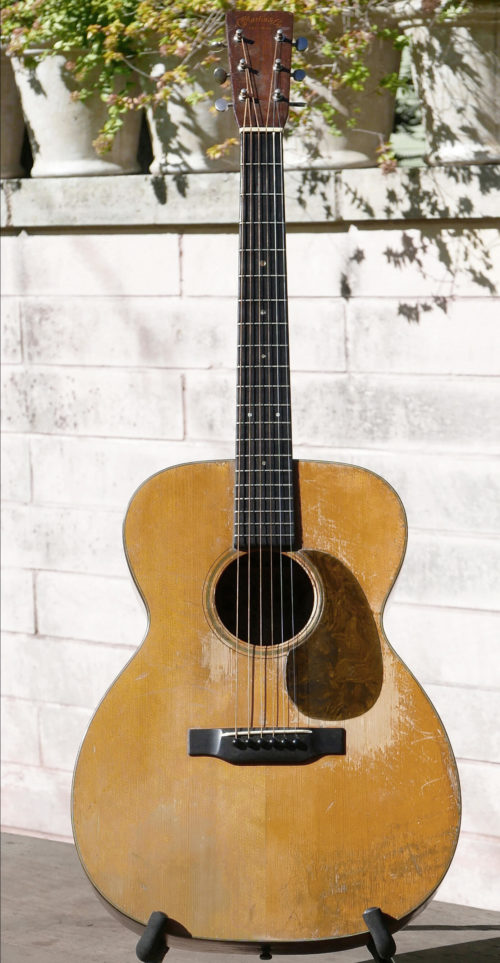 Impossible to mistake this guitar for a “1937 Authentic” or some such “recreation”. This 000-18 left the Martin factory in Nazareth, in 1937, indeed. And it’s been well-played since. More importantly, the tone is stellar– all you would expect from this style, this year, and more. Its bass response is similar to the best prewar D-18s. And it has the unmistakable string separation that only prewar Martins have. This instrument was in the family of its original owner until we obtained it. The original owner was Leroy Jenkins, a blind country artist in the 1950’s, in Texas, on the Dude label.
Impossible to mistake this guitar for a “1937 Authentic” or some such “recreation”. This 000-18 left the Martin factory in Nazareth, in 1937, indeed. And it’s been well-played since. More importantly, the tone is stellar– all you would expect from this style, this year, and more. Its bass response is similar to the best prewar D-18s. And it has the unmistakable string separation that only prewar Martins have. This instrument was in the family of its original owner until we obtained it. The original owner was Leroy Jenkins, a blind country artist in the 1950’s, in Texas, on the Dude label. -
 Nothing sounds like a 30’s Gibson L-00. No longer a sleeper on the vintage guitar market–they are sought after by working musicians the world over¬–they are still under-rated on the collector market. These mid-size Gibsons are incredibly resonant. There is nothing like them, from Gibson, and the mid-size Adirondack spruce over mahogany Martins from the mid to late 30’s command more than twice the price. This L-00 from 1938 has the best tone of any of the 30’s L-00’s we’ve seen. You won’t believe its presence. Acquired by us from the family of the original owner in Austin, Texas, this guitar is a great example of the era when Gibson still had a production jump on Martin, and even its lower cost guitars were winning the marketing war at the trailing end of the depression. This L-00 had a re-spray of its burst in the early 60’s, so while not the original finish, it’s got the right look and feel of the 30’s, and plenty of mileage to make it more than convincing. The top and sides are completely crack-free, and there are only two small cracks on the back. One is not through the wood, and the other was expertly addressed by Tony Nobles with a small cleat. Tony also made a new perfect reproduction Brazilian Rosewood bridge. The bridge plate is original and in great condition. Original firestripe pickguard. Original nut. The non-original tuners on the instrument when we acquired it were replaced by us with klusons from the period. Tony also installed new T-frets. While we tend to specialize in vintage Martins, this one might change my mind.
Nothing sounds like a 30’s Gibson L-00. No longer a sleeper on the vintage guitar market–they are sought after by working musicians the world over¬–they are still under-rated on the collector market. These mid-size Gibsons are incredibly resonant. There is nothing like them, from Gibson, and the mid-size Adirondack spruce over mahogany Martins from the mid to late 30’s command more than twice the price. This L-00 from 1938 has the best tone of any of the 30’s L-00’s we’ve seen. You won’t believe its presence. Acquired by us from the family of the original owner in Austin, Texas, this guitar is a great example of the era when Gibson still had a production jump on Martin, and even its lower cost guitars were winning the marketing war at the trailing end of the depression. This L-00 had a re-spray of its burst in the early 60’s, so while not the original finish, it’s got the right look and feel of the 30’s, and plenty of mileage to make it more than convincing. The top and sides are completely crack-free, and there are only two small cracks on the back. One is not through the wood, and the other was expertly addressed by Tony Nobles with a small cleat. Tony also made a new perfect reproduction Brazilian Rosewood bridge. The bridge plate is original and in great condition. Original firestripe pickguard. Original nut. The non-original tuners on the instrument when we acquired it were replaced by us with klusons from the period. Tony also installed new T-frets. While we tend to specialize in vintage Martins, this one might change my mind. -
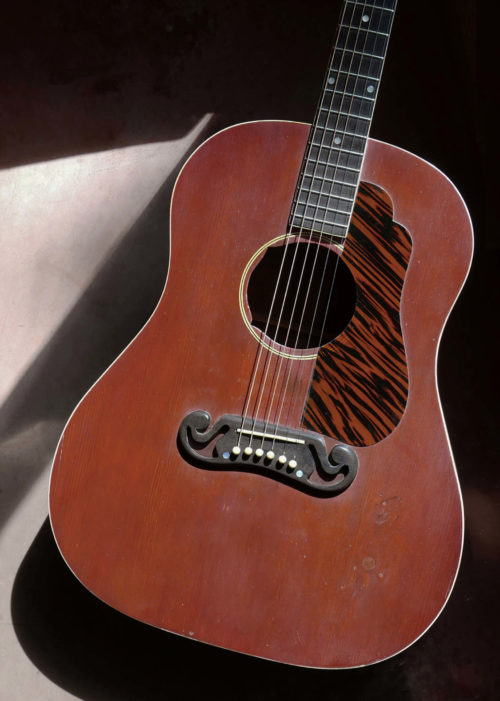 This is not your father’s J-55. And it’s not a $20K guitar. It is a wonderful player. This is an original 1939 Gibson Jumbo 55, also called the “J-55”, serial # EA5652. It is the rare, stair step headstock model, only made for a brief window in the late 30’s. It delivers the trademark, large body, prewar, long scale Gibson tone, like no other. It plays beautifully, with original bridge, frets, braces. This guitar has of course the original, Mustache bridge, and more rare– the stair step headstock. Original bridge plate. Original binding including on fretboard. Original pearl logo on the headstock (with original finish). The pickguard is a nitro cellulose reproduction meticulously crafted in our shop. It has the long scale, 25 ½ inches, that makes this model so great. And a little-known original feature of this rare model is that it has a 1 11/16 nut width, that combined with the low action makes it effortless to play, and with tone that cannot be equaled in any postwar Gibson. The intonation is spot-on, and the intonation and fretting/action are great even at the high fret positions. It was refinished in a deep Gibsonesque red, decades ago– and that makes this guitar the most affordable true 1939, stairstep headstock J-55 you will ever find. (Top thickness is fine, there was no thinning in the past). The tone is superb. And the action is superb– low and fast without sacrificing tone or volume at all.
This is not your father’s J-55. And it’s not a $20K guitar. It is a wonderful player. This is an original 1939 Gibson Jumbo 55, also called the “J-55”, serial # EA5652. It is the rare, stair step headstock model, only made for a brief window in the late 30’s. It delivers the trademark, large body, prewar, long scale Gibson tone, like no other. It plays beautifully, with original bridge, frets, braces. This guitar has of course the original, Mustache bridge, and more rare– the stair step headstock. Original bridge plate. Original binding including on fretboard. Original pearl logo on the headstock (with original finish). The pickguard is a nitro cellulose reproduction meticulously crafted in our shop. It has the long scale, 25 ½ inches, that makes this model so great. And a little-known original feature of this rare model is that it has a 1 11/16 nut width, that combined with the low action makes it effortless to play, and with tone that cannot be equaled in any postwar Gibson. The intonation is spot-on, and the intonation and fretting/action are great even at the high fret positions. It was refinished in a deep Gibsonesque red, decades ago– and that makes this guitar the most affordable true 1939, stairstep headstock J-55 you will ever find. (Top thickness is fine, there was no thinning in the past). The tone is superb. And the action is superb– low and fast without sacrificing tone or volume at all. -
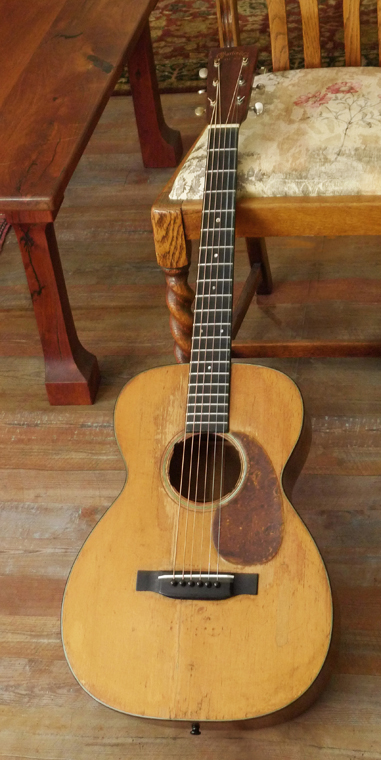 This guitar is probably among the first twenty Martins made in 1939 after the change in nut width on 14-fret models from 1 3/4" to 1 11/16", so yes it is 1 11/16. It has all original finish. Original tuners. Original maple bridge plate. It has multiple repaired cracks on top and sides (no cracks on back). Extensive play wear. New, but perfect, historically correct reproduction Ebony bridge.
This guitar is probably among the first twenty Martins made in 1939 after the change in nut width on 14-fret models from 1 3/4" to 1 11/16", so yes it is 1 11/16. It has all original finish. Original tuners. Original maple bridge plate. It has multiple repaired cracks on top and sides (no cracks on back). Extensive play wear. New, but perfect, historically correct reproduction Ebony bridge. -
 We called it the “Tony Rice” prewar 000-18. Is it the "tony rice" style slightly enlarged soundhole (done decades ago). All original finish.
We called it the “Tony Rice” prewar 000-18. Is it the "tony rice" style slightly enlarged soundhole (done decades ago). All original finish. -
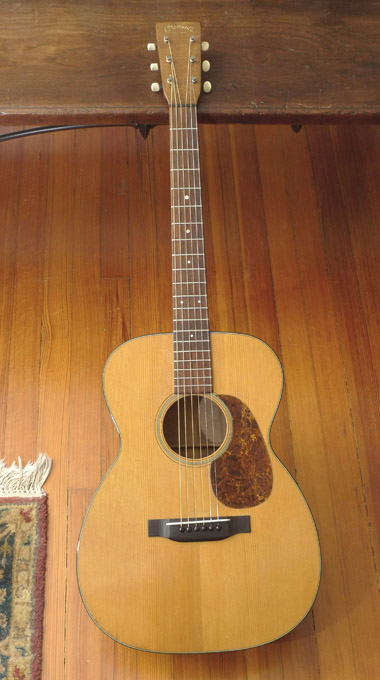 This is a prime example of why the pre-war, scalloped brace Martins made in 1943 in particular are the best sounding Martins ever: the ebony truss rod in the neck (instead of a metal truss rod– due to wartime metal rationing), the even more finely scalloped tone bars, and lack of metal tuner post bushings, all contribute to the lightness of build, and the robust tone, resonance and sustain you won’t find on any other Martin (not even the mid-30’s Martins). This guitar, seemingly light as a feather, plays like a dream, and is particularly resonant, and wonderful, for fingerpicking. (Martins from this year, often have a thinner finish, as does this one, which also contributes to its almost Shaker-like simplicity and beauty.) All original finish still in great shape. It has just had a new, Brazilian rosewood bridge made (from 100 year old, old-growth Brazilian rosewood, to the exact shape and footprint of the original which had a crack and was better replaced) by Tony Nobles (original bridge will ship, in the case). The bridge is hide-glued on, naturally. Aside from the typical B-string area “pickguard crack”, now well repaired and a non-issue, the top of the guitar is crack free. There is one well-repaired crack on the back. There was an old input jack right below the end pin, now filled expertly by Nobles (but no evidence of any pickups etc inside the guitar).
This is a prime example of why the pre-war, scalloped brace Martins made in 1943 in particular are the best sounding Martins ever: the ebony truss rod in the neck (instead of a metal truss rod– due to wartime metal rationing), the even more finely scalloped tone bars, and lack of metal tuner post bushings, all contribute to the lightness of build, and the robust tone, resonance and sustain you won’t find on any other Martin (not even the mid-30’s Martins). This guitar, seemingly light as a feather, plays like a dream, and is particularly resonant, and wonderful, for fingerpicking. (Martins from this year, often have a thinner finish, as does this one, which also contributes to its almost Shaker-like simplicity and beauty.) All original finish still in great shape. It has just had a new, Brazilian rosewood bridge made (from 100 year old, old-growth Brazilian rosewood, to the exact shape and footprint of the original which had a crack and was better replaced) by Tony Nobles (original bridge will ship, in the case). The bridge is hide-glued on, naturally. Aside from the typical B-string area “pickguard crack”, now well repaired and a non-issue, the top of the guitar is crack free. There is one well-repaired crack on the back. There was an old input jack right below the end pin, now filled expertly by Nobles (but no evidence of any pickups etc inside the guitar).- Original bridge plate, in fine condition. Original Frets.
- Original tuners (it looks like at one point there were other tuners on the guitar… with a few old screw holes filled.)
- Has never had strap lug attached to heel
- Top shows no “bellying”. Natural shape and slight arch is textbook perfect.
-
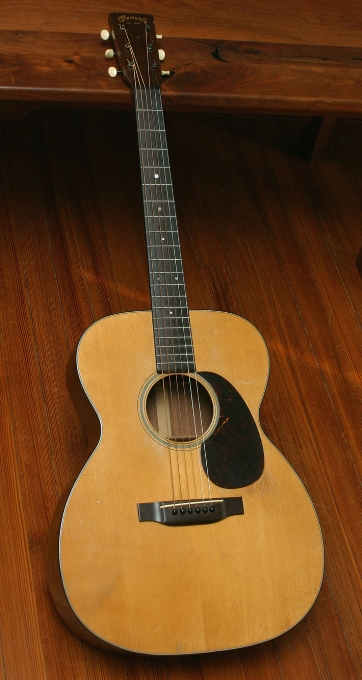 A rare, 100% original pre-war Martin. Not a crack anywhere. And though it of course has the 1-11/16 inch nut, it plays remarkably like the wider nut mid-30's 000-18's due to the generous (original) string spacing at the nut. Original finish. Neck has never been re-set. Original Ebony nut, ivory saddle, full height original bridge. Original tuners. Original plastic tuner buttons in great condition (no shrinkage). Lack of tuner ferrels of course (because of war-time metal shortages). Brazilian rosewood bridge, fingerboard, and peghead veneer. Scalloped braces. Original bridge plate. Frets show minor/normal wear. It shows light/normal pick wear around the soundhole (nothing anywhere near down to bare wood). Other minor superficial scratches on back, and sides. Bass tone and volume is impressive-the characteristic of war-time "pre-war" Martins, that featured more deeply scalloped braces. Many believe these more deeply scalloped braces found only in these years give them better tone than the mid-30s Martins. It does need a standard neck set. It's not egregiously out of set, action is a bit high at 12th fret. But due the originality of the instrument, original ivory saddle still hide glued-in, etc., we believe the buyer would want to set the neck to their liking. (We would be happy to set the neck for the new owner if desired, at no additional charge, after purchase.) The tone: gold standard pre-war 000-18. Loud, dark, crisp, and clear.
A rare, 100% original pre-war Martin. Not a crack anywhere. And though it of course has the 1-11/16 inch nut, it plays remarkably like the wider nut mid-30's 000-18's due to the generous (original) string spacing at the nut. Original finish. Neck has never been re-set. Original Ebony nut, ivory saddle, full height original bridge. Original tuners. Original plastic tuner buttons in great condition (no shrinkage). Lack of tuner ferrels of course (because of war-time metal shortages). Brazilian rosewood bridge, fingerboard, and peghead veneer. Scalloped braces. Original bridge plate. Frets show minor/normal wear. It shows light/normal pick wear around the soundhole (nothing anywhere near down to bare wood). Other minor superficial scratches on back, and sides. Bass tone and volume is impressive-the characteristic of war-time "pre-war" Martins, that featured more deeply scalloped braces. Many believe these more deeply scalloped braces found only in these years give them better tone than the mid-30s Martins. It does need a standard neck set. It's not egregiously out of set, action is a bit high at 12th fret. But due the originality of the instrument, original ivory saddle still hide glued-in, etc., we believe the buyer would want to set the neck to their liking. (We would be happy to set the neck for the new owner if desired, at no additional charge, after purchase.) The tone: gold standard pre-war 000-18. Loud, dark, crisp, and clear. -
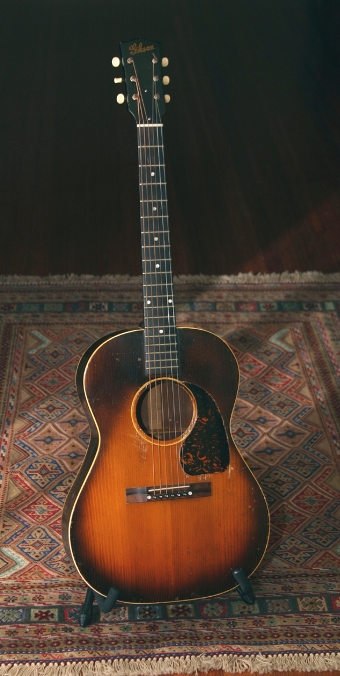 (No serial number or FON, these years often do not have one.) This completely crack-free, Script logo LG-2 is a jewel. A lot of players say the script logo Gibsons from right after the war are better sounding and better-built guitars than the Banner Gibsons. All of the good things about Banners, but with better craftsmanship. All original finish, everywhere. Mahogany back and sides. Spruce top. Not a crack anywhere. 1-3/4" nut. The bridge is an excellent quality rosewood replacement. Original maple plate. Original tuners. Replaced nut and saddle. Rosewood fingerboard shows moderate wear on first couple of frets. Some of that wonderful Gibson 40’s crazing to the finish, but not at all out of hand. Various pick marks, and dings. Original tuners, bridge, plate. Piezo pickup was skillfully de-installed, and endpin jack removed and plugged. One of the finest Script logo LG-2s you’ll find.
(No serial number or FON, these years often do not have one.) This completely crack-free, Script logo LG-2 is a jewel. A lot of players say the script logo Gibsons from right after the war are better sounding and better-built guitars than the Banner Gibsons. All of the good things about Banners, but with better craftsmanship. All original finish, everywhere. Mahogany back and sides. Spruce top. Not a crack anywhere. 1-3/4" nut. The bridge is an excellent quality rosewood replacement. Original maple plate. Original tuners. Replaced nut and saddle. Rosewood fingerboard shows moderate wear on first couple of frets. Some of that wonderful Gibson 40’s crazing to the finish, but not at all out of hand. Various pick marks, and dings. Original tuners, bridge, plate. Piezo pickup was skillfully de-installed, and endpin jack removed and plugged. One of the finest Script logo LG-2s you’ll find. -
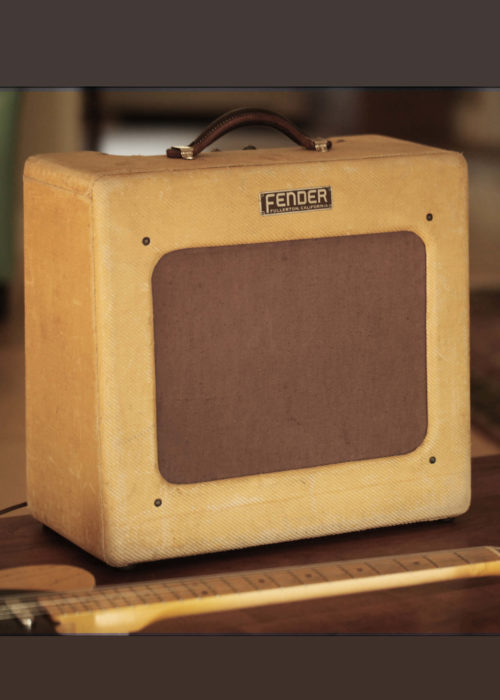 1951 Fender Deluxe Amplifier ... all it should be, and more... coming soon... . .
1951 Fender Deluxe Amplifier ... all it should be, and more... coming soon... . .